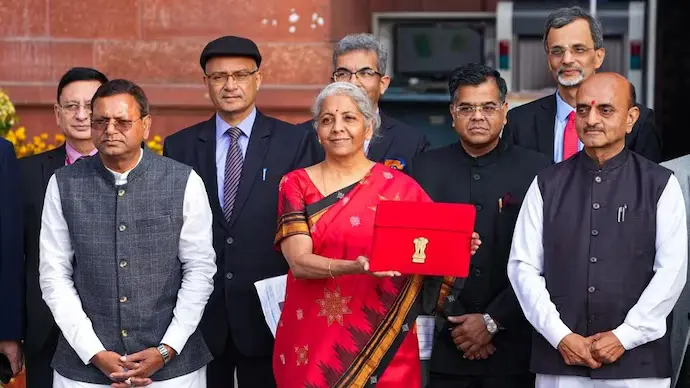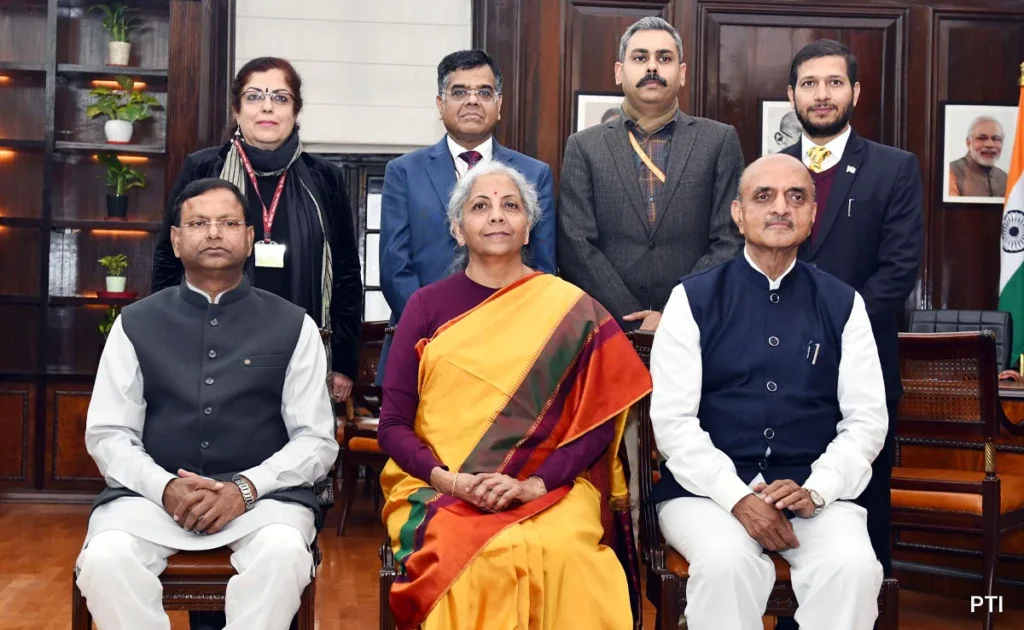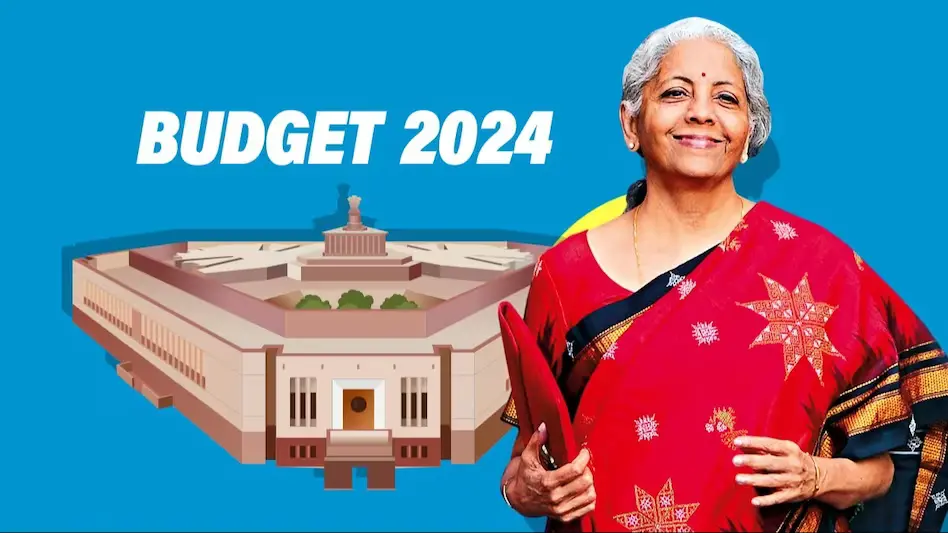FM Nirmala Sitharaman presented the Interim Budget in the Lok Sabha today. Earlier in the morning, the Union Cabinet met and approved the Budget.
Budget Summary
Taxation and Fiscal Deficit
Unchanged Tax Rates and Fiscal Strategy
- No Tax Rate Changes: Finance Minister Nirmala Sitharaman proposes no change in direct and indirect tax rates, including import tax, retaining the same tax rates for direct and indirect taxes.
- Fiscal Deficit Target: The government aims to reduce the fiscal deficit target to 5.1% of GDP in the upcoming fiscal year, further targeting 4.5% in FY26.
- Tax Reforms Impact: Tax reforms have widened the tax base, increased tax collections, and led to the doubling of the tax base of GST.
Tourism and Air Connectivity
- Interest-free Loans for Tourism: Interest-free loans to states will be provided to promote tourism.
- Enhanced Air Connectivity: The government plans to launch 517 new routes under the Udan Scheme to improve air connectivity.
Fiscal Announcements and Rail Allocation
- Capex Outlay: The capital expenditure (Capex) outlay for the next fiscal year is set at Rs 11.11 lakh crore, reflecting 3.4% of GDP.
- Railway Allocation: An allocation of Rs 2.55 lakh crore is made for the railways, focusing on economic corridors, port connectivity, and urban transformation.
PLI Scheme and Agriculture
- PLI Scheme Allocation: The Production-Linked Incentive (PLI) scheme receives an allocation of Rs 6,200 crore.
- Agricultural Initiatives: The budget aims to promote investment in post-harvest activities, empower dairy farmers, and expand the application of Nano-DAP in agro-climatic zones.

Infrastructure and Renewable Energy
Railway Corridors and Urban Transformation
- Economic Railway Corridors: Three major economic railway corridors are planned under the PM Gati Shakti to improve logistics efficiency and reduce costs.
- Urban Transformation: The budget emphasizes the promotion of urban transformation through Metro rail and NaMo Bharat, with a focus on high-speed train conversions.
Renewable Energy and PLI Scheme
- Viability Gap Funding: Viability gap funding is proposed for wind energy, along with the setting up of coal gasification and liquefaction capacity.
- Mandatory Blending: Phased mandatory blending of CNG, PNG, and compressed biogas is planned to promote renewable energy sources.
Housing and Healthcare
- Housing Initiatives: A new housing plan for the middle class and the construction of 2 crore houses under the PM Aavas Yojana are highlighted.
- Healthcare Expansion: Healthcare facilities under Ayushman Bharat will be extended, and the health sector will receive Rs 90,170 crore, 13.8% higher than the previous year’s estimate.
Education and Economic Growth
- Education Budget: The education budget for 2024/25 is projected at Rs 1.25 lakh crore, reflecting a 14.5% increase from the previous year’s estimate.
- India’s Growth Trajectory: The next five years are projected to be years of unprecedented growth, with a focus on reforms and the eastern region as a driver of growth.
Social Welfare and Empowerment
Empowerment Initiatives
- Women’s Participation: Women’s participation in higher education has risen to 28% in the last 10 years, reflecting the government’s focus on women’s empowerment.
- Financial Assistance: Credit assistance to street vendors, Mudra loans, and skill development initiatives are highlighted as part of the government’s empowerment efforts.
Poverty Alleviation and Dignity of Women

- Poverty Alleviation: The government has uplifted 25 crore people out of poverty in the last 10 years, focusing on the welfare of Garaab, Yuva, Mahila, and Annadata.
- Dignity of Women: Legal reforms, reservation in Parliament, and financial assistance under various schemes have enhanced the dignity of women in India.
Healthcare Expansion and Economic Transformation
- Healthcare Access: The extension of healthcare facilities, vaccination programs, and nutrition delivery initiatives are aimed at improving healthcare access.
- Economic Transformation: The government’s focus on governance, development, and performance has led to significant economic transformation and development.
Governance and Financial Prudence
- Financial Prudence: Direct transfers to beneficiaries, savings through Jan Dhan accounts, and the elimination of food worries through free rations are highlighted as examples of financial prudence.
- Good Governance: The government’s emphasis on good governance, development, and performance has led to the fruits of development reaching every stratum of society.
Vision for India’s Future
Development Milestones and Economic Reforms
- Milestones and Achievements: The President highlighted significant milestones and achievements, including economic reforms, infrastructure development, and social welfare initiatives.
- Interim Budget’s Role: The interim budget serves as a provisional financial plan during an election year, addressing immediate financial needs until a new government is in place.
Prime Minister’s Vision and Government’s Accomplishments
- Disha Nirdesh for India: The Prime Minister’s vision for India’s future and the government’s accomplishments in various sectors are emphasized as part of the budget session.
- Future Reforms: The government aims to undertake the next generation of reforms in consultation with state governments, focusing on unprecedented growth and development.
Post-Election Budget and Policy Declarations
- Comprehensive Union Budget: The comprehensive union budget will be unveiled post-elections, refraining from making significant and far-reaching policy declarations in the interim budget.
- Government’s Positive Outlook: The Indian economy, once categorized as part of the “fragile five,” is currently advancing positively and at a suitable pace, attributed to various governmental reforms enacted during this period.
Economic Transformation and National Achievements
- Transformation and Achievements: The budget session emphasizes the economic transformation, national achievements, and the government’s positive outlook for India’s future growth and development.
- Government’s Positive Impact: The government’s positive impact on the economy, infrastructure, and social welfare is highlighted, reflecting a vision for India’s future.
